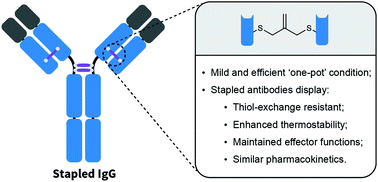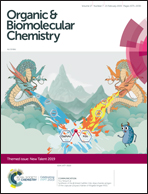One-pot stapling of interchain disulfides of antibodies using an isobutylene motif†
Abstract
Monoclonal antibodies have emerged as an important class of therapeutics in oncological and autoimmune diseases due to their several attractive properties, such as high binding affinity and specificity. However, it has recently become clear that antibodies recovered from serum show a significantly decreased potency owing to various reasons, including deamidation, oxidation, fragment antigen binding (Fab) exchange, and disulfide shuffling. Fab exchange and disulfide shuffling result because of the instability of disulfides in serum. Herein, we reported a ‘one-pot’ stapling strategy using isobutylene motifs to stabilise the interchain disulfides of antibodies. This general method was applied to a Fab fragment of the anti-HER2 antibody. The stapled Fab was completely stable in the presence of biological thiols. The approach was further applied to two different full-length IgGs, trastuzumab and rituximab, under mild and biocompatible conditions. The binding affinity of the antibody was enhanced, relative to its native form, after being stapled. The stapled structure maintained its effector functions and behaved similarly to its native form in vivo. This work provides a straightforward and scalable method for the stabilisation of antibodies in various formats.

- This article is part of the themed collections: Chemical Biology in OBC and New Talent


 Please wait while we load your content...
Please wait while we load your content...